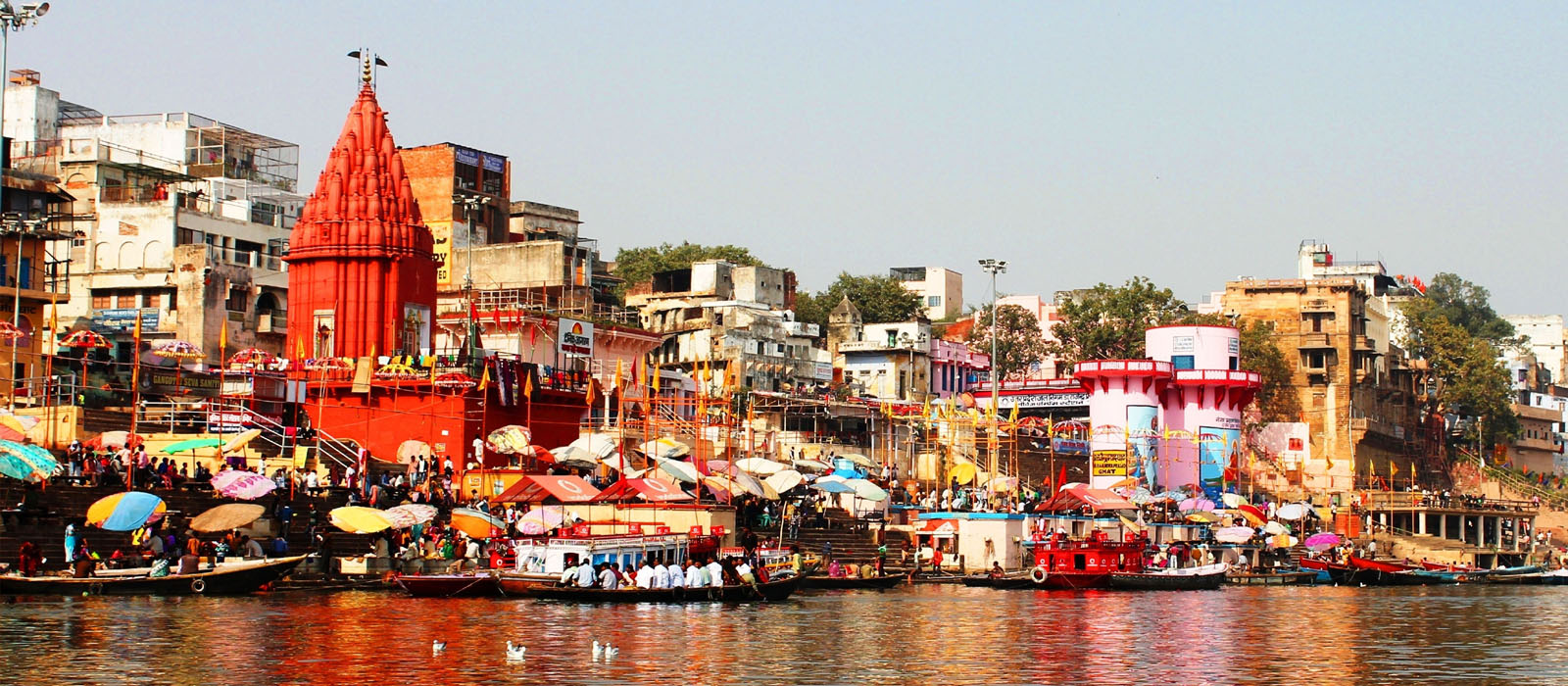
Varanasi City
- Kashi Vishwanath Temple
- Ghat
- Ramnagar Fort
- Sankat Mochan Hanuman Temple
- Sarnath Museum
Kashi Vishwanath Temple
Kashi Vishvanath Temple is one of the most famous Hindu temples dedicated to Lord Shiva. It is located in Varanasi, Uttar Pradesh, India. The temple stands on the western bank of the holy river Ganga, and is one of the twelve Jyotirlingas, the holiest of Shiva temples. The main deity is known by the name Vishvanatha or Vishveshvara meaning Ruler of The Universe. Varanasi city is also called Kashi, and hence the temple is popularly called Kashi Vishvanath Temple.
The temple has been referred to in Hindu scriptures for a very long time as a central part of worship in the Shaiva philosophy. It has been destroyed and re-constructed a number of times in history. The last structure was demolished by Aurangzeb, the sixth Mughal emperor who constructed the Gyanvapi Mosque on its site.[1] The current structure was built on an adjacent site by the Maratha ruler, Ahilya Bai Holkar of Indore in 1780.
Located on the banks of the holy Ganges, Varanasi is regarded among the holiest of the Hindu cities. The Kashi Vishwanath temple is widely recognized as one of the most important places of worship in Hindu religion. Inside the Kashi Vishvanath Temple is the Jyotirlinga of Shiva, Vishveshvara or Vishvanath. The Vishveshvara Jyotirlinga has a very special and unique significance in the spiritual history of India.
Many leading saints, including Adi Sankaracharya, Ramakrishna Paramhansa, Swami Vivekananda, Bamakhyapa, Goswami Tulsidas, Swami Dayananda Saraswati, Sathya Sai Baba and Gurunanak have visited the site.[20] A visit to the temple and a bath in the river Ganges is one of many methods believed to lead one on a path to Moksha (liberation). Thus, Hindus from all over the world try to visit the place at least once in their lifetime. There is also a tradition that one should give up at least one desire after a pilgrimage the temple, and the pilgrimage would also include a visit to the temple at Rameswaram in Tamil Nadu in Southern India, where people take water samples of the Ganges to perform prayer at the temple and bring back sand from near that temple. Because of the immense popularity and holiness of Kashi Vishwanath temple, hundreds of temples across India have been built in the same architectural style. Many legends record that the true devotee achieves freedom from death and saṃsāra by the worship of Shiva, Shiva devotees on death being directly taken to his abode on Mount Kailash by his messengers and not to Yama. The superiority of Shiva and his victory over his own nature—Shiva is himself identified with death—is also stated. There is a popular belief that Shiva himself blows the mantra of salvation into the ears of people who die naturally at the Vishwanath temple
Ghats in Varanasi are riverfront steps leading to the banks of the River Ganges. The city has 88 ghats. Most of the ghats are bathing and puja ceremony ghats, while two ghats are used exclusively as cremation sites.
According to the puranic sources, there are five key ghats on the riverfront, important because of their association with a defining feature of the holy city of Kashi: Assi Ghat, Dashashwamedh Ghat, Manikarnika Ghat, Panchganga Ghat and Adi Keshav Ghat[3].
Assi Ghat:
This ghat that used to lie at the confluence of the Ganges with the dry river Asi marks the traditional southern boundary of the city. Asisangameshwar Temple at the ghat finds mention in the Kashi Khand of Skandmahapuran.This ghat is very popular because it is one of the very few ghats that is linked with the city through a wide street.Assi ghat name is given as it is the 80th ghat.PM MODI launched water ATM on 17th sep ,2015 on occasion of PM bithday.
Dashashwamedh Ghat:
Dashashwamedh Ghat is located close to Vishwanath Temple, and is probably the most spectacular ghat. Two Hindu mythologies are associated with it: According to one, Lord Brahma created it to welcome Lord Shiva. According to another, Lord Brahma sacrificed ten horses, during Dasa-Ashwamedha yajna performed here. A group of priests daily perform in the evening at this ghat "Agni Pooja" (Worship to Fire) wherein a dedication is made to Lord Shiva, River Ganges, Surya (Sun), Agni (Fire), and the whole universe.
Manikarnika Ghat:
Two legends are associated with Manikarnika Ghat.[citation needed] According to one, it is believed to be the place where Lord Vishnu dug a pit with his Chakra and filled it with his perspiration while performing various penances. While Lord Shiva was watching Lord Vishnu at that time, the latters earring ("manikarnika") fell into the pit. According to the second legend, in order to keep Lord Shiva from moving around with his devotees, his consort Goddess Parvati hid her earrings, and asked him to find them, saying that they had been lost on the banks of the Ganges. Goddess Parvatis idea behind the fib was that Lord Shiva would then stay around, searching forever for the lost earrings. In this legend, whenever a body gets cremated at the Manikarnika Ghat, Lord Shiva asks the soul whether it has seen the earrings.
According to ancient texts, the owner of Manikarnika Ghat bought King Harishchandra as a slave and made him work on the Manikarnika at Harishchandra Ghat. Hindu cremations customarily take place here, though a majority of dead bodies are taken for cremation to the Manikarnik Ghat. According to other sources that Manikarnik Ghat is named after Jhansi ki Rani Laxmibhai.
Ramnagar fort is a sandstone-fortified structure that was built in 18th century. It is located near the river bank. Kashi Naresh, the king of Varanasi, constructed the building. The present king, Anant Narayan Singh lives in the fort now. The fort might not have its prime shine now, but, it is an aesthetically pleasing structure.
Why this Fort is so famous?
Ramnagar fort is a fortified building made with cream-colored sandstone built in Mughal styled architecture. The fort includes Veda Vyasa temple, Dakshin Mukhi Hanuman temple, museum, big astronomical clock, carved balconies, pavilions, open courtyards, Durbar hall and reception room. The private residence area of the king is not opened for tourists.
Museum of the fort :
The museum inside the fort is also called as Sarawati Bhawan. This bhawan was a public audience hall in the past. Today, the museum holds a rare collection of ivory works, vintage cars of America, medieval costumes, gold ornaments, silver works, sedan chairs, palanquins, old guns, elephant saddles and others.There are many books, manuscripts, Mughal miniature illustrated books and others are also found here.
Astronomical clock :
The fort contains a rare clock, which shows time, day, week, month and astronomical details about the position of planets, moon and the sun. This clock was built in 19th century by an astronomer in the court of Varanasi king.
Sankat Mochan Hanuman Temple is a Hindu temple in Varanasi, Uttar Pradesh, India and is dedicated to the Hindu God Hanuman. The temple was established by famous Hindu preacher and poet saint Sri Goswami Tulsidas in the early 1500s and is situated on the banks of the Assi river. The deity was named "Sankat Mochan" meaning the reliever from troubles.
In the temple, offerings to Lord Hanuman (called Prasad) are sold like the special sweet "besan ke ladoo", which the devotees relish; the idol is also decked with a pleasant marigold flower garland as well. This temple has the unique distinction of having Lord Hanuman facing his Lord, Rama, whom he worshiped with steadfast and selfless devotion.
History
It is believed that the temple has been built on the very spot where Tulsidas had a vision of Hanuman.[2] Sankat Mochan Temple was founded by Tulsidas who was the author of the Ramacharitamanasa, which is the greatest version of lord Ram story written in Avadhi ("Most of the people having confusion that Ramacharitamanasa is a avadhi version of Valmiki Ramayana but Ramacharitamanasa is different from Sanskrit Ramayana written by rishi Valmiki as Baba Tulsidas Ji already told in Ramacharitamanasa that "Nana bhanti Ram avatara, Ramayan sat koti apara" means in each Kalp lord Ram takes Avatar & plays different-2 lilas(Act) so we have different stories of same lord Ram").Tradition promises that regular visitors to the temple will gain the special favor of Lord Hanuman. Every Tuesday and Saturday thousands of people queue up in front of the temple to offer prayers to Lord Hanuman. According to Vedic Astrology, Hanuman saves human beings from the anger of the planet Shani (Saturn), and especially people who have an ill-placed Saturn in their horoscopes visit this temple for astrological remedies. This is supposed to be the most effective way for appeasing Shani. While it is suggested that Hanuman did not hesitate to engulfs in his mouth the sun, the lord of all planets, which humbled all the gods and angels, making them worship him for the Suns release. Some astrologers believe that worshiping Hanuman can neutralize the ill-effect of Mangal (Mars) and practically any planet that has an ill effect on human life.
Sarnath Museum is the oldest site museum of Archaeological Survey of India. It houses the findings and excavations at the archaeological site of Sarnath, by the Archaeological Survey of India.
Sarnath is an incredible town of significance to Buddhists and I recommend visiting the temples that the worlds Buddhist countries have built here. Within this museum is the incredible Ashoka Pillar which is the first thing you see when you come in. Beyond this is a wing filled with early stone images of the Banaras, one in particular has the most serene expression of any I have seen anywhere in Asia. Unfortunately, I did not purchase the museum guide and have been unable to identify the statue since visiting.
Galleries
The museum contains five galleries and two verandahs to display the antiquities ranging from the 3rd century BCE to 12th century AD that have been found at Sarnath.
Sarnath has yielded a rich collection of sculptures, artefacts and edifices comprising numerous Banaras and Bodhisattva images and other ancient remains. Finest specimens of Buddhist art and other important remains have been housed at the museum.
While the single most famous exhibit of this museum is the Lion Capital of Ashoka, the Sarnath museum also houses a collection of other Buddhist artefacts. Among the things to see is a sculpture of the Banaras from the 5th century. The Banaras sits cross-legged, with eyes downcast in deep meditation, and a halo around his head. Also worth exploring are the several figures of the bodhisattvas.
Ashoka Lion capital
This is the famous original sandstone sculpted Lion Capital of Ashoka preserved at Sarnath Museum, which was originally erected around 250 BCE atop an Ashoka Pillar at Sarnath. The angle from which this picture has been taken, minus the inverted bell-shaped lotus flower, has been adopted as the National Emblem of India showing the Horse on the left and the Bull on the right of the Ashoka Chakra in the circular base on which the four Indian lions are standing back to back. On the far side there is an Elephant and a Lion instead. The wheel "Ashoka Chakra" from its base has been placed onto the centre of the National Flag of India.

